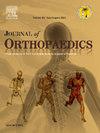Accuracy of total knee arthroplasty using hospital-based 3D printed patient-specific instrumentation: A radiology research
IF 1.5
Q3 ORTHOPEDICS
引用次数: 0
Abstract
Background
Patient-specific instruments (PSIs) were reported to improve implant position and rotation accuracy in total knee arthroplasty (TKA), among other benefits. Most PSIs used in TKA were commercial products from implant manufacturers, which could be time-consuming and could potentially affect accuracy as they relied on engineer's decision. This study aimed to present the radiological outcomes of PSI produced by the 3D printing facility at our hospital, with direct involvement of the surgeon in its design.
Methods
This prospective study enrolled 45 patients who underwent mechanically aligned TKA. Preoperative whole-limb 3D-CT scans were obtained to create the sizing plan. The surgeon identified the position of the cut plane and guide pin locations on software, which were then forwarded to engineers for further processing. Subsequently, the PSI was fabricated using in-hospital 3D resin printers. During surgery, after removing all remaining cartilage, the PSI was utilized on the bone surfaces to assist surgeons in drilling pinhole positions for the manufacturer's cutting instruments. Post-surgery, CT scans were acquired and overlaid onto the 3D model of the implant to compare to the plan.
Results
On average, it took three days to prepare for the surgery using PSI. 100 % of patients had implant sizes that matched the preconception template. The mean postoperative hip-knee angle was 178.1° ± 1.34°. The mean femoral component rotation angle relative to the surgical transepicondylar axis (sTEA) and the mean rotation mismatch between the femur and tibial component were 0.99° ± 0.84° and 0.91° ± 1.61°, respectively.
Conclusions
Preliminary radiological results demonstrated that in-hospital PSI was a useful technique for improving the accuracy of implant positioning in TKA, especially in controlling the rotational alignment.
使用基于医院的 3D 打印患者特异性器械进行全膝关节置换术的准确性:一项放射学研究
背景据报道,患者专用器械(PSI)可提高全膝关节置换术(TKA)中植入物位置和旋转的准确性,并具有其他优点。在全膝关节置换术中使用的大多数 PSI 都是假体制造商的商业产品,这可能会耗费大量时间,而且由于它们依赖于工程师的决定,可能会影响准确性。本研究旨在介绍我院 3D 打印设备生产的 PSI 的放射学结果,外科医生直接参与了 PSI 的设计。术前进行全肢 3D-CT 扫描,以制定尺寸计划。外科医生在软件上确定切割平面的位置和导针位置,然后将其转发给工程师进行进一步处理。随后,使用院内 3D 树脂打印机制作了 PSI。手术期间,在切除所有剩余软骨后,PSI 被用于骨骼表面,以协助外科医生为制造商的切割器械钻孔。手术后,医生会采集 CT 扫描,并将其叠加到种植体的 3D 模型上,以便与计划进行比较。100%的患者植入的假体尺寸与预想的模板相符。术后髋膝角度平均为 178.1° ± 1.34°。结论初步的放射学结果表明,院内 PSI 是提高 TKA 植入物定位精度的有效技术,尤其是在控制旋转对位方面。
本文章由计算机程序翻译,如有差异,请以英文原文为准。
求助全文
约1分钟内获得全文
求助全文
来源期刊

Journal of orthopaedics
ORTHOPEDICS-
CiteScore
3.50
自引率
6.70%
发文量
202
审稿时长
56 days
期刊介绍:
Journal of Orthopaedics aims to be a leading journal in orthopaedics and contribute towards the improvement of quality of orthopedic health care. The journal publishes original research work and review articles related to different aspects of orthopaedics including Arthroplasty, Arthroscopy, Sports Medicine, Trauma, Spine and Spinal deformities, Pediatric orthopaedics, limb reconstruction procedures, hand surgery, and orthopaedic oncology. It also publishes articles on continuing education, health-related information, case reports and letters to the editor. It is requested to note that the journal has an international readership and all submissions should be aimed at specifying something about the setting in which the work was conducted. Authors must also provide any specific reasons for the research and also provide an elaborate description of the results.
 求助内容:
求助内容: 应助结果提醒方式:
应助结果提醒方式:


